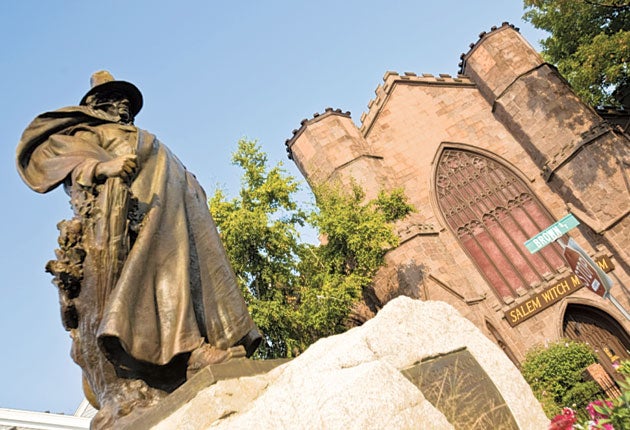Salem, Massachusetts: The New England town with the darkest past

Your support helps us to tell the story
From reproductive rights to climate change to Big Tech, The Independent is on the ground when the story is developing. Whether it's investigating the financials of Elon Musk's pro-Trump PAC or producing our latest documentary, 'The A Word', which shines a light on the American women fighting for reproductive rights, we know how important it is to parse out the facts from the messaging.
At such a critical moment in US history, we need reporters on the ground. Your donation allows us to keep sending journalists to speak to both sides of the story.
The Independent is trusted by Americans across the entire political spectrum. And unlike many other quality news outlets, we choose not to lock Americans out of our reporting and analysis with paywalls. We believe quality journalism should be available to everyone, paid for by those who can afford it.
Your support makes all the difference."Don't worry, I'm the scariest thing here," jokes the guide at Salem Witch Village. This isn't saying a lot. Clad in hooded top, surf shorts and flip-flops, he looks less a teller of gory tales in a "museum" of lumpen waxworks than a man who has taken a wrong turn on his way to the beach. But at least he has made more effort with his appearance than the "exhibits" – a hangman and his rickety gallows, a medieval torture victim on a dusty rack, a dragon sitting next to the fire exit.
Mr Dress-Down Friday is one of the modern faces of Salem, the Massachusetts town whose name still casts a shadow thanks to the madness that tore it apart in the late 17th-century. Between February 1692 and May 1693 it was the centre of a hysterical judicial process that saw 26 people convicted of witchcraft – 19 were hanged – and many more accused.
Yet three centuries on, Salem has, ironically, embraced the very bête noire it was seeking to expel in those 16 dark months. Not literally – you won't see pale maidens dancing with the devil on its streets. But you will encounter all manner of Hallowe'en-shaped attractions – gaudy frightfests keen to trade on the town's notoriety.
The word "witch" crops up endlessly in the six blocks that once formed the colonial Salem. Almost every shop touts occult-themed products. Anyone wanting a pentagram T-shirt, a plastic skull or a sign that says "Parking For Witches Only: All Others Will Be Toad" is in the right town. A new-age emporium, Angelica Of The Angels, advertises séances "Every Friday and Saturday, 7-9". Even Salem Cycle has a logo of a witch on a bike.
Just as odd is the statue of Samantha Stephens, the suburban witch played by Elizabeth Montgomery in the US sitcom Bewitched. Seeing it at the corner of Essex Street, I feel unnerved at the tacit suggestion that a Sixties TV series and a legalised massacre are the same thing. Because the events of 1692 were tragic – a superstitious community, isolated on the edge of an unknown continent, devouring itself. Petty disputes morphed into accusations of diabolical deeds, the insanity stoked by the mischief and malice of the star "witnesses" – a group of bored teenage girls willing to condemn any who crossed them.
The panic has become a metaphor for persecution and paranoia, notably in The Crucible, Arthur Miller's 1953 play, which used the trials as an allegory for the fear of Communist influence that infected US government in the Fifties.
It takes me a while to unearth solid traces of 1692. The Witch House, though heavily restored, is the only surviving building of the time. The former home of Jonathan Corwin, one of the judges, it throws out echoes of the era – creaking floorboards and photostat transcripts of trial "evidence" in spidery scrawl. At the Old Town Hall, a live re-enactment, Cry Innocent, recalls the fate of Bridget Bishop, the first of those convicted to be executed.
But it is this battle between fact and fantasy that makes Salem such a fascinating place to visit. Certainly, it is worth a day trip from Boston, 20 miles to the south – not least if you are travelling with children, whose presence should ensure that the likes of Count Orlok's Nightmare Gallery are transformed from tacky boltholes to palaces of ghoulish thrills.
And if you look carefully, a charming New England town is trying to peep out. The Peabody Essex Museum does art and architecture; the Salem Regional Visitor Center explores the history of the town and region beyond 1692; Jaho is the sort of cosy coffee lounge at which America excels. And the harbour is a reminder that Salem still has a maritime role – as it did before the trials sealed its image.
In the end, though, I too succumb to the hysteria – by supping a pint of Pumpkinhead at Salem Beer Works, a microbrewery that makes 40 speciality ales. There is a definite taste of Halloween to its potency. But then, in a town where it is Halloween every day, it would be churlish to drink anything else.
Travel essentials: Salem
Getting there
* American Airlines (08457 789 789; aa.com) and its partner British Airways (0844 493 0787; ba.com) together fly six times a day from Heathrow to Boston; in addition, Virgin Atlantic (0844 209 7777; virgin-atlantic.com) flies daily on the same route.
Staying there
* The Salem Waterfront Hotel at 225 Derby Street (001 978 740 8788; salemwaterfronthotel.com) has double rooms starting from $129 (£82).
More information
Join our commenting forum
Join thought-provoking conversations, follow other Independent readers and see their replies
Comments